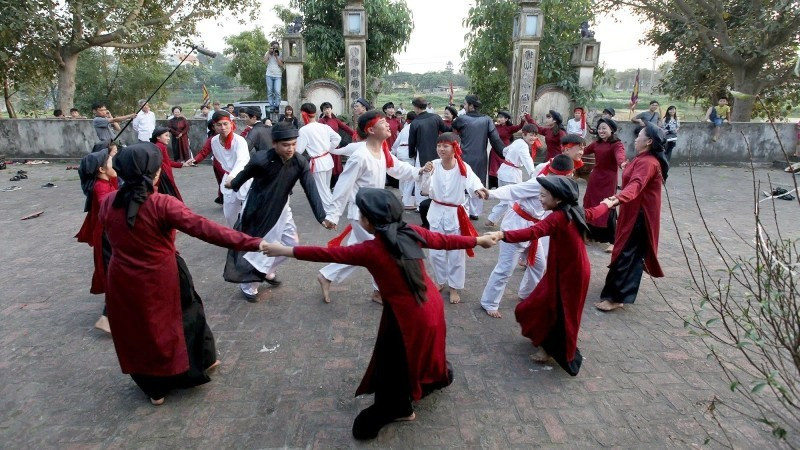Developing Viet Nam’s heritage ecosystem
As Viet Nam operates a two-tier local government model and is accelerating digital transformation, the preservation and utilisation of heritage must aim towards building a comprehensive, inclusive and harmonious ecosystem.

Potential and requirements from heritage resources
In July 2025, Viet Nam received two pieces of encouraging news: the complex of Yen Tu, Vinh Nghiem, Con Son-Kiep Bac relics and scenic sites, together with Phong Nha-Ke Bang National Park (Viet Nam) and Hin Nam No National Park (Laos), were inscribed on the UNESCO World Heritage List. This marks the first time Viet Nam has possessed a transboundary heritage site. The event not only enriched the national “heritage map” but also expanded the heritage ecosystem to a scale of management and utilisation that extends beyond national borders.
In reality, many heritage sites, once recognised by UNESCO, have become drivers of economic growth. Non Nuoc Cao Bang Global Geopark, recognised in 2018, has become a major tourist attraction in Cao Bang Province. The province has linked sustainable development with cultural preservation and environmental protection, established over 700 grassroots art clubs, revived Then singing and dan tinh performances, and tied tourism with community livelihoods.
Hoi An Ancient Town (Da Nang), recognised by UNESCO in 1999, is exemplary in combining urban architectural preservation with community-based experience services, making tourism a spearhead economic sector.
The Trang An Landscape Complex (Ninh Binh), inscribed by UNESCO in 2014, has become a major centre of ecological, cultural and spiritual tourism in northern Viet Nam. Together with Tam Coc-Bich Dong and Van Long, this site gained international attention when chosen as a filming location for the Hollywood movie Kong: Skull Island.
The Trang An Complex also contributed significantly to Ninh Binh’s tourism in 2024, welcoming 8.7 million visitors, including 1.5 million international arrivals, with revenue exceeding 9.1 trillion VND (345.3 million USD). The attraction of heritage continues to spread as the Bollywood film Silaa, with a budget of around 4 million USD, is set to be filmed in August at several Vietnamese scenic sites, including Son Doong Cave (Quang Tri).
In 2025, Viet Nam is also finalising two dossiers for nomination to the Asia-Pacific regional documentary heritage list: the Pho Hien steles system (Hung Yen) and the Sino-Nom inscriptions on Non Nuoc Mountain (Ninh Binh). Its rich heritage resources and diverse materials provide a foundation for Viet Nam to expand international cooperation, mobilise resources from experts, receive technical support in conservation, and learn advanced models of heritage management and utilisation.
This is also the basis for enhancing capacity in preparing regional and global dossiers so that national heritage may achieve a worthy presence on the world heritage map. However, whether holding UNESCO or national titles, each heritage site requires a comprehensive and inclusive management mechanism to bring out its inherent outstanding values.
Creating spaces for heritage to shine
Previously, many localities proactively formed regional linkages, tapping into heritage values tied to cultural tourism development, forming the model of “one route - multiple destinations” that connects areas with similar cultural heritage values. Regional linkages at that stage may be seen as the first steps in the mindset of building a heritage ecosystem.
Accordingly, heritage was no longer isolated but positioned at the centre of interlinked relationships with infrastructure, communities, service markets and communications. Entering a new stage, with 34 provinces and cities, room for development is expanding, creating more opportunities for forming large-scale heritage linkage models. However, some localities also face challenges in harmonising preservation and development.
According to Nong Viet Yen, Director of the Lao Cai Department of Culture, Sports and Tourism, many intangible cultural heritage elements recognised by UNESCO or listed nationally are distributed across two or three communes. This requires a reasonable decentralisation mechanism and coordination across sectors, regions and levels.
In reality, many heritage sites, though located in one province, possess values of national or even international significance. Therefore, beyond physical space, the heritage ecosystem needs to encompass institutional frameworks and cooperative networks spanning sectors, regions and levels, where policies, communities, researchers, businesses and international partners all participate in honouring heritage values.
Moreover, an ecosystem mindset means restructuring development strategies to deepen heritage values, from zoning for protection and rational utilisation, to designing specialised product chains, creating continuous travel routes to lengthen visitor stays, boost spending and generate revenue for reinvestment in conservation and human resource training.
In tourism, heritage is a unique resource, but to attract and retain visitors it must be combined with transport, accommodation, cuisine, experiences and destination marketing. The linkage mechanism between heritage and other sectors is considered the conduit for the heritage ecosystem to operate effectively. If attention is paid solely to preservation without connection to other sectors, heritage values will struggle to gain broad recognition.
Therefore, cross-sector linkages with education, tourism, and the economy, as well as international cooperation, are needed to promote heritage through cinema, media and global events. Many experts have suggested developing geological heritage tours across the three Global Geoparks of Dong Van Karst Plateau, Non Nuoc Cao Bang and Lang Son, as well as a Northwest heritage route.
On the basis of geological heritage, tourism products are simultaneously created and interconnected, linking resources among localities. Geological values are transformed into experience services, accommodation, cuisine and distinctive handicrafts, thereby generating employment and bringing benefits to communities. A circular, inclusive and closely connected ecosystem will enhance attractiveness and highlight the values of geological heritage.
In the digital era, technology has proven to be a pillar of development ecosystems. For heritage, it offers a new mode of conservation and a solution to create added value in utilisation and promotion, becoming a bridge to make heritage come alive in contemporary life. Many localities such as Ha Noi, Ho Chi Minh City, Hue and Quang Ninh have early on applied modern technology in conserving and promoting heritage values, from digitising records, building open databases, applying virtual reality in exhibitions to promoting on social networks and e-commerce.
As a result, heritage has been spread globally, particularly attracting younger generations. The application of new technologies at the Temple of Literature in Ha Noi and the Hue Imperial Citadel shows that when data, experience and education are connected, heritage becomes vibrant and attuned to modern life. However, digital heritage data is still fragmented and lacks connectivity, requiring integration into a national system towards a digital heritage map of Viet Nam to serve research, management, education, tourism and creative start-ups.
From efforts in conservation, infrastructure investment, cultural tourism product development, gradual digital transformation, communication and promotion that have contributed to building Viet Nam’s heritage brand on the world map, it is now time to link these separate stages into a long-term strategy that harmonises preservation and sustainable development.
When placed within a comprehensive development structure, heritage - with its unique appeal - can become a powerful driver of green growth, digital transformation and deeper international integration It also serves as a soft power resource affirming national identity while enhancing Viet Nam’s standing and competitiveness on the international stage.








